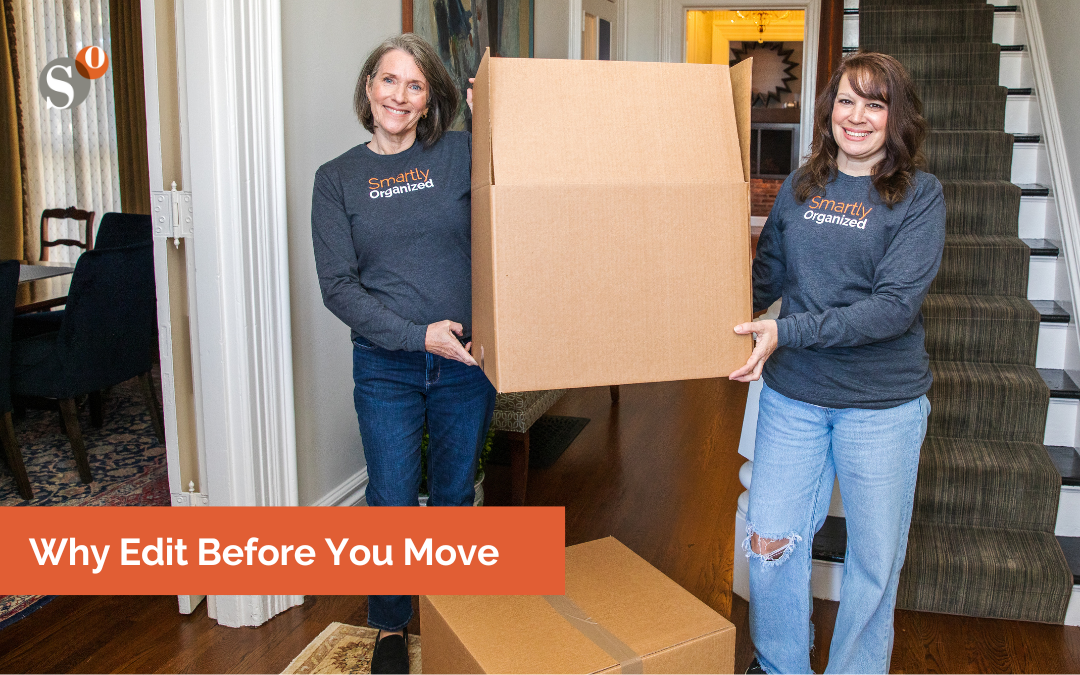The Downsides of Not Editing Before You Move
Not editing your belongings before a move can lead to some serious challenges. Let’s break it down in a way that keeps the focus on simplifying your life and making the move stress-free.
Failing to edit your belongings can lead to several significant challenges:
- Overwhelm on Moving Day: Moving everything can create chaos and stress, making it feel like you’re moving a storage unit rather than your home.
- Increased Costs: More items mean bigger moving trucks and potentially higher labor costs, adding to the financial burden.
- Difficulty Settling In: Clutter from your old space can delay your ability to feel at home in your new environment.
- Clutter Creep: Moving items you don’t use can lead to clutter taking over your new space, making it harder to maintain organization.
- Decision Fatigue: Facing decisions about what to keep after the move can lead to exhaustion and prolong the settling-in process.
Why It’s Hard to Let Go
Letting go of belongings can be emotionally tough because items often hold memories, represent past identities, or trigger “what if” thoughts about future use. Fear of making the wrong decision or losing a part of yourself can cause resistance. Sometimes, clutter even provides comfort or security, making it difficult to release. It’s not just about decluttering; it’s about processing emotions tied to your belongings and your past.
Simplified Ways to Make Decluttering Easier
- Start Small: Tackle one drawer or closet at a time to prevent overwhelm.
- Set Clear Intentions: Visualize how you want your new space to feel, guiding your decisions.
- One-Year Rule: If you haven’t used an item in the past year, consider letting it go.
- Make It Fun: Challenge yourself with time limits or mini-games to keep the process engaging.
- Prioritize Keepsakes: Focus on items that bring joy or serve a purpose in your new life.
- Get Support: Enlist a friend or a professional organizer for encouragement and accountability.
- Take Breaks: Allow yourself to step away if you feel emotionally drained.
- Create a Maybe Box: Place uncertain items in a box to revisit later without pressure.
- Celebrate Wins: Acknowledge your progress to stay motivated and uplifted.
How Long It Can Take
1. Home Size and Volume of Belongings
- Small Apartment (1-2 bedrooms):
- Time Estimate: 1-2 weeks
- Why: With fewer rooms and belongings, editing can usually be done in manageable chunks over a week or two.
- Medium-Sized Home (3-4 bedrooms):
- Time Estimate: 2-4 weeks
- Why: More rooms mean more items, but focusing on one space at a time (such as the kitchen, closets, or storage areas) will keep it manageable.
- Large Home (5+ bedrooms, including storage spaces like garages or basements):
- Time Estimate: 4-6 weeks
- Why: Larger homes typically have more storage spaces and belongings, so it takes longer to thoughtfully declutter each area without feeling rushed. The time needed to declutter depends on the size of your home and how quickly you make decisions.
To stay on track, dedicate 1-2 hours a day, focusing on one space at a time. Areas like kitchens, garages, and sentimental items may require more time, but overall, breaking the process into smaller tasks keeps it manageable.
2. Your Editing Style
- Fast Decision-Makers:
- Time Estimate: 1-2 hours per room
- Why: If you’re decisive and don’t get too emotionally attached to items, you can move through the process quickly. This approach works well if you give yourself focused time blocks to get it done.
- Deliberate Decision-Makers:
- Time Estimate: 2-4 hours per room
- Why: If you need time to think about each item and how it fits into your life, it’s important to honor that process. Spreading it out over a few days or weeks allows you to make thoughtful decisions without feeling rushed.
3. High-Clutter Areas
- Kitchens, Garages, or Storage Rooms:
- Time Estimate: 4-6 hours per space
- Why: These spaces tend to accumulate more random items, tools, and gadgets. Giving yourself extra time for these areas ensures you don’t get bogged down by decision fatigue.
4. Emotional Attachments
- Sentimental Items:
- Time Estimate: Varies
- Why: Sentimental items like photos, heirlooms, and personal mementos often take the most time because they come with emotional weight. Consider working on these items last, or take breaks if it starts to feel too overwhelming.
What Categories to Consider when Downsizing
To avoid the overwhelming feeling of editing your entire home we recommend chunking down the project by category. The decision process varies depending on the category. By focusing on one category at a time, you avoid mentally switching gears and gain momentum as you move through one category at a time. Common categories include:
- Clothes: Let go of anything you haven’t worn in a year.
- Papers: Shred outdated documents and digitize important ones.
- Beauty Products: Toss expired or unused items.
- Kitchen Gadgets: Donate or recycle unused appliances.
- Electronics and Cords: Recycle outdated devices and cables.
- Books: Keep favorites, donate or gift the rest.
- Sentimental Items: Keep a few cherished pieces and let go of what no longer serves you.
- Toys/Kids’ Items: Donate outgrown items and focus on what’s currently in use.
By editing your belongings thoughtfully, you’ll avoid overpacking and start fresh in a clutter-free home. Ready to take the first step? Schedule your Smart Reset today!


